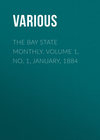Kitabı oku: «The Journal of Negro History, Volume 7, 1922», sayfa 4
Somewhat later than this, another group of Negro schools developed in Cabell County, the first and most important being in Guyandotte and Barboursville. These schools followed as a result of employment of Negroes on the Chesapeake and Ohio railroad, terminating in the seventies at the Ohio River, where it gave rise to the city of Huntington, West Virginia, laid out in 1870. Most of these Negroes, prominent among whom were James Woodson, Nelson Barnett, and W. O. James, came from Virginia. The first school established near Huntington was opened in the log house on Cemetery Hill, one and a half miles east of the town and a little west of Guyandotte. The Negro school enumeration was so small that the two towns had to cooperate in maintaining one school.
The teacher first employed was Mrs. Julia Jones, a lady who had most of the rudiments of education. Some old citizens refer to James Liggins as the first teacher in this community. In this precarious status of stinted support the school did not undergo any striking development during the first years. Not until 1882, some years after the school had been removed to Huntington itself, was there any notable change. The first impetus which marked an epoch in the development of this school came with the employment of Mr. and Mrs. W. F. James, products of the Ohio school system. They were for their time well-prepared teachers of foresight, who had the ability to arouse interest and inspire the people. Mr. James at once entered upon the task of the thorough reorganization of the school and by 1886 brought the institution to the rank of that of the grammar school, beginning at the same time some advanced classes commonly taught in the high schools. He was an earnest worker, willing to sacrifice everything for the good of the cause. While thus spending his energy as a sacrifice for many he passed away respected by his pupils and honored by the patrons of the school. His wife continued for a number of years thereafter to render the system the same efficient service as the popular primary teacher upon which the success of the work of the higher grades largely depended, until she passed away in 1899.
The school then had the services of Mr. Ramsey and Mr. J. B. Cabell who seemingly gave some impetus to the forward movement. Another epoch in the history of the school was reached when W. T. McKinney became principal in 1891. With the cooperation of the leading Negroes of the city he succeeded in inducing the board of education to build on the corner of Sixteenth Street and Eighth Avenue the Douglass High School, which in its first form, prior to the making of certain additions, consisted of a well-built six-room school costing several thousand dollars. Mr. McKinney added the high school course and in the year 1893 graduated the first class of three. Following Mr. McKinney there served the system efficiently as principals C. H. Barnett from 1890 to 1900, C. G. Woodson from 1900 to 1903, and R. P. Sims from 1903 to 1906. J. W. Scott, who succeeded Mr. Sims, is today principal of this school, ranking throughout the State as one of its foremost educators.
Following along the line of Wayne County there soon appeared a school at Ceredo and another at Fort Gay, just across the river from Louisa, Kentucky. Under Mrs. Pogue, a woman of ambition and efficiency, this school accomplished much good and exerted an influence throughout that county. A number of students trained through the sixth, seventh, and eighth grades later attended schools in other parts and made good records because of the thorough training they first received. At Fort Gay in this same county, however, no such desirable results were achieved because of the small Negro population, the inability to secure teachers for the small amount paid, and the tendency on the part of local trustees there to change their teachers. Mrs. Cora Brooks Smith, a graduate of the Ironton High School, who toiled there a number of years, and Miss Susie Woodson, an alumnus of the Douglass High School of Huntington, West Virginia, who also labored in the same field, should be given at least passing mention in any sketch setting forth the achievements in education among the Negroes in Wayne County.
The Strivings in Southern West Virginia
In southern West Virginia there were at first few schools for Negroes, inasmuch as the small Negro groups here and there did not warrant the outlay. What instruction such Negroes received prior to 1888 was largely private. That year an epoch was marked in the development of the southern portion of the State by the completion of the main line of the Norfolk and Western Railroad, opening up one of the largest coal fields in the United States. As the discontented Negroes of Virginia and North Carolina were eager for industrial opportunities in the mining regions of the Appalachian Mountains, these coal fields attracted them in large numbers. Bluefield, which developed in a few years from a barren field in 1888 to a town of almost ten thousand by 1900, indicates how rapidly the population there increased. Other large centers of industry, like Elkhorn, Northfork, Welch, and Keystone, soon became more than ordinary mining towns.
When these places had worn off the rough edges of frontier settlement and directed their attention to economic and social welfare, they naturally clamored for education. The first school for whites was established in Bluefield in 1889 and one for the Negroes, with Gordon Madson as teacher, followed in 1890. Prominent among the pioneering teachers in Bluefield were Mr. A. J. Smith and Mrs. L. O. McGhee, who began their work in a one-room log building in the suburbs of the town. About the end of the nineties there were Negro schools in most of the important mining towns along the Norfolk and Western Railroad between Bluefield and Williamson.
The Negro school in Bluefield had an interesting history. The school, of course, was poorly equipped and the teachers were not then adequately paid, but they continued their work two sessions of five months each. In the third year the school was moved to another town called Cooperstown where it was housed in a two-room building more comfortable than the first structure, but not a modern establishment. As it was situated in crowded quarters, the children had no playground. Several years thereafter, the work was continued by Mr. Patterson and Mrs. E. O. Smith. When, however, a large Negro population settled in North Bluefield it was necessary to provide there a two-room building between them. In this school-house taught Mr. P. J. Carter with an enrolment of about thirty pupils. Not long thereafter the building in the suburb of Cooperstown was burned. Two additional rooms were then annexed to that of North Bluefield, but before that could be occupied it was also destroyed in the same way. The Board of Education then opened a school, in a building used first as a bar-room, then as a pool-room, and finally as a courthouse. Thereafter an old store-room was used for four years.
There were then four teachers in Bluefield, Mr. H. Smith, Mr. T. P. Wright, Mesdames Lane, and E. C. Smith. In time Mr. Wright and Mr. Smith were replaced by Miss H. W. Booze, Mr. W. A. Saunders and Mr. R. A. McDonald. Mr. Saunders remained for one year and then was followed by Mr. G. W. Hatter who was in his turn succeeded by Mr. R. F. Douglass, who served as principal four years. Mr. Douglass had the board of education appropriate funds for a six-room building and increase the corps of teachers to five. By raising funds in the community through entertainments and the like, the teachers purchased a library of 100 volumes. In later years Mr. Douglass was followed by Mr. E. L. Rand, a graduate of Lincoln University.
At Keystone in 1890 Mr. J. A. Brown opened its first Negro school with an enrolment of about twenty-five. He was a man of fair education, but could not accomplish very much because the term was only three months in length. The school was held in one of the private houses belonging to the coal company and later in the church. In subsequent years there was very much development in the right direction, which proved the quality of the teachers employed in the school. Among these were Rev. J. Whittico, Mrs. Josephine D. Cannady, Mary A. McSwain, and Maggie Anderson. This school was later combined to form the Keystone-Eckman graded school, and now has an eight months' term and well-qualified teachers.52 A school had been established at Eckman in 1893 by James Knox Smith.
In November, 1892, one Moses Sanders at Northfork opened a school with an enrolment of twenty. He had only a rudimentary education. He served at Northfork for three terms using methods considered fair for that time, and his work, as a whole, was regarded as successful. He had there the support of such a useful person as Henry Glenn, now a member of the board of education.53 This school has later developed into a standard elementary graded school and a junior and senior high school of more than one hundred students. It has done well under the reorganization and direction of the efficient J. W. Robinson.
Higher Education of Negroes
It did not require much argument to show that the schools could not make much progress without some provision for developing its own teaching force. The State Superintendent was early authorized, therefore, to arrange with some school in the State for the professional training of Negro teachers. For a number of years the State depended largely upon such normal training as could be given at Storer College at Harper's Ferry. The reports of the State Superintendent of Schools carried honorable mention from period to period of the successful work being accomplished there under the direction of Dr. N. C. Brackett, which work was the only effort for secondary education for Negroes in the State at that time. This was given an impetus by a measure introduced in the legislature by Judge James H. Ferguson of Charleston, providing for an arrangement with Storer College by which eighteen persons as candidates for teachers in this State should be given free tuition at that institution. As this school was in the extreme northeastern section of the State and was geographically a part of Maryland and Virginia, however, the Negroes of the central and southern portions of Virginia soon began the movement for the establishment of a Negro school providing for normal instruction nearer home. Mr. William Davis and his corps of teachers in Charleston, West Virginia, were among the first in West Virginia to direct attention to this crying need. Impetus was also given the movement by the rapid development of higher grades in Point Pleasant, Saint Albans, Montgomery, Lewisburg and Eckman, necessitating better trained teachers. In the summers of 1890, 1891, and 1892, Byrd Prillerman and H. B. Rice undertook to supply this need by conducting a summer school in the city of Charleston. Still further stimulus came later from the establishment of promising high schools in Parkersburg, Wheeling, Clarksburg, Huntington, and Charleston.
During this same period, however, a systematic effort was being made to interest a larger group in the more efficient training of Negro leaders. The Baptists of the State, led by C. H. Payne, undertook to establish a college in West Virginia. Payne toured the State in behalf of the enterprise, setting forth the urgent need for such an institution and showing how this objective could be attained. Rallying to this call, the people of the State raised a sum adequate to purchase a site, which was soon sought by authority of the Baptists of the State. They selected the abandoned building and grounds of Shelton College, overlooking Saint Albans. Because of race prejudice, however, the people of that town started such a protest that the owners of the property were induced not to sell the site for such an unpopular purpose.
A more successful effort, however, was soon made. Talking with Superintendent Morgan about the necessity for higher education for the Negroes of West Virginia, Byrd Prillerman obtained from this official the promise to support a movement to supply this need. Superintendent Morgan furthermore directed Prillerman to Governor Fleming to take up with him the same proposal. The Governor was in a receptive mood and informed Prillerman, moreover, that this problem could be more easily solved than he had at first thought, for the reason that such an institution could be so established as to benefit by the Morrill Land Grant Act intended to subsidize, with funds from the proceeds of public lands, institutions largely devoted to instruction in Agriculture. Like the Negro Baptists of the State, Governor Fleming thought of purchasing Shelton College in St. Albans; but inasmuch as that place was not available the State government had to take more serious action. As Governor Fleming said he would give his approval to a bill for the establishment of such an institution, the only problem to be then solved was to find persons to pilot such a measure through the legislature. Superintendent Morgan outlined the plans for this legislation. He showed how necessary it was to secure the support of Mr. C. C. Watts and Judge James H. Ferguson. Byrd Prillerman used his influence in securing the support of Mr. Watts and C. H. Payne induced Judge Ferguson to lend the cause a helping hand. These gentlemen framed the measure which, after some unnecessary debate and unsuccessful opposition from friends of Storer College, they piloted through the legislature in 1891 as a measure establishing the West Virginia Colored Institute.
The first head of this institution was James E. Campbell, a graduate of the Pomeroy High School. After laying the foundation and popularizing the work to some extent in the central portion of the State, Campbell resigned and was succeeded by J. H. Hill, who rendered very efficient service until 1899, when he was succeeded by J. McHenry Jones, under whom the school considerably expanded. Following him came Byrd Prillerman, a man beloved by the people of West Virginia. He had already been a successful teacher of English in this school. He then served the institution as president for ten years, emphasizing the high ideals of Christian character as the essentials in the preparation of youth. In 1915 a collegiate course was established at this institution and its name was changed to that of the West Virginia Collegiate Institute. In 1919 Byrd Prillerman was succeeded by John W. Davis, under whom the institution is progressing with renewed vigor in its new field as a reorganized college furnishing facilities for education not offered elsewhere for the youth of West Virginia.
The influx of Negroes into the southern counties of the State, which necessitated the establishment of many elementary schools, caused at the same time a demand for the extension of the facilities of pedagogic training of the advanced order provided in the West Virginia Colored Institute, which was not at first easily accessible to the people of southern West Virginia. Acting upon the memorials, praying that this need be supplied, the legislature established the Bluefield Colored Institute in 1895. Mr. Hamilton Hatter was made the first principal and upon him devolved the task of organizing this institution. After serving the institution efficiently until 1906 he retired, and was succeeded by Mr. R. P. Sims, who had formerly been an efficient and popular assistant under Mr. Hatter at this institution. Mr. Sims has acceptably filled this position until the present time.
The West Virginia Teachers' Association
To promote education and to encourage interest in their particular work the Negro teachers of the State soon deemed it wise to take steps for more thorough cooperation of the whole teaching corps of West Virginia. White and Negro teachers were then admitted to the same teachers' institutes and in certain parts were encouraged to participate in the general discussions; but believing that they could more successfully cooperate through organizations of their own, the teachers in Charleston, in 1891, appointed from their own reading circle a committee to organize a State Teachers' Association. This committee was composed of H. B. Rice, P. B. Burbridge and Byrd Prillerman. The meeting was invited by Byrd Prillerman, as secretary, to meet at the Simpson M. E. Church in Charleston. More than fifty teachers and race leaders attended. Inasmuch as H. B. Rice, the chairman of the committee, was absent on account of illness, P. B. Burbridge, whose name was second on the list of the committee, called the meeting to order, and delivered the address of welcome. William T. McKinney of Huntington was elected temporary chairman. The Association was then permanently organized by naming Byrd Prillerman its first president and Mrs. Rhoda Weaver its first secretary. Among the most important addresses was that of C. H. Payne, an influential and educated minister then engaged in religious and editorial work at Montgomery, and that of B. S. Morgan, State Superintendent of Public Schools. Others attending the meeting were Dr. W. T. Merchant, Mrs. E. M. Dandridge, Mrs. M. A. Washington-Thompson, F. C. Smith, and J. R. Jefferson.54
The second meeting of this Association assembled according to arrangement in Parkersburg, West Virginia. The work of the Association had by this time been taken more seriously by the teachers throughout the State. They adopted a constitution with a preamble which stated that the aim of the Association was "to elevate the character and advance the interest of the profession of teaching, and to promote the cause of popular education in the State of West Virginia." An address was delivered by State Superintendent of Schools B. S. Morgan, and papers were read by Mrs. E. M. Dandridge of Quinnimont, Miss Blanche Jeffries of Charleston, Miss Coralie Franklin of Storer College, and Principal J. E. Campbell of the West Virginia Colored Institute. Among the persons attending but not appearing on the program were C. H. Barnett, who had been recently graduated by Dennison University in Ohio; C. H. Payne, then well known in the State of West Virginia; Dr. W. S. Kearney, a graduate of the medical college of Shaw University, then beginning his practice in Huntington; J. R. Jefferson, F. C. Smith and O. A. Wells. Booker T. Washington was at this time made an honorary member. Byrd Prillerman was unanimously elected president.
The third annual meeting of the Association was held at Parkersburg, West Virginia, in 1893. For some reason there were not many teachers present. It was held at the Baptist Church of that city, with President Byrd Prillerman presiding. The address of welcome was delivered by Mr. J. R. Jefferson, to the words of whom Mr. C. W. Boyd of Charleston responded. At this meeting Principal J. E. Campbell of the West Virginia Colored Institute was made president of the Association, with C. W. Boyd, J. R. Jefferson, Miss Mary F. Norman as vice-presidents, Miss Clara Thomas as secretary, Miss E. D. Webster as treasurer, and Mrs. Susie James as historian. Two of the most prominent persons participating in this meeting were J. McHenry Jones, then principal of the high school in Wheeling, and J. H. Hill, an instructor in the West Virginia Colored Institute.
The fourth annual meeting assembled at Montgomery. J. E. Campbell being absent, Professor C. W. Boyd presided. The meeting to a certain extent was a successful one. A Thanksgiving sermon was preached by Dr. C. H. Payne. Dr. H. F. Gamble read a paper on "Science in Common School Education." The Association took high ground by adopting a resolution urging a compulsory school law. A committee consisting of C. W. Boyd, Rev. G. B. Howard, J. W. Scott, John H. Hill, and Byrd Prillerman, was appointed to urge the State to make an appropriation for the teaching fund of the West Virginia Colored Institute. Byrd Prillerman was again elected President and Miss Fannie Cobb was chosen secretary.
The fifth annual meeting of the Association was held at Hinton. An important feature of the meeting was the method of entertainment, in that the citizens of Hinton gave the teachers a free banquet. Still more significant was the address delivered by Dr. J. E. Jones of the Richmond Theological Seminary. Byrd Prillerman, the President, himself delivered an important address giving valuable facts as to the conditions of the schools of the State, evoking widely extended comment. The most prominent persons attending were J. H. Hill, Principal of the West Virginia Colored Institute, G. B. Howard, Miss Mary Booze, W. T. McKinney, and Miss G. E. Fulks.55
The sixth annual meeting was held in Charleston in the House of Delegates, November 26-27, 1896. This was the largest and most interesting meeting hitherto held. Welcome addresses were delivered by C. W. Boyd of the Garnet High School, Mr. George L. Laidley, Superintendent of the Charleston Public Schools, and Governor W. A. McCorkle. Responses to the words of welcome were delivered by J. H. Hill, principal of the West Virginia Colored Institute, Hamilton Hatter, principal of the Bluefield Colored Institute, and C. H. Payne. Other prominent persons who attended the meeting were Honorable V. A. Lewis, P. F. Jones, Colonel B. W. Byrne, Professor A. L. Wade, J. R. Jefferson, Rev. D. W. Shaw, Dr. G. W. Holley, P. B. Burbridge, Dr. H. F. Gamble, Dr. L. B. Washington, Mrs. E. M. Dandridge, Mrs. M. A. W. Thompson and Mrs. Byrd Prillerman. Officers elected were: President, Byrd Prillerman; Vice Presidents, J. R. Jefferson, Mrs. E. M. Dandridge, C. W. Boyd; Secretary, Miss Mary J. Jones; Treasurer, Mrs. M. A. W. Thompson; Historian, Mr. George L. Cuzzins.
After this meeting of such unusual interest and unexpected success, the West Virginia Teachers' Association reached its purely pedagogic setting. It ceased to be the organization concerned with the general social uplift, of all, and thereafter restricted its program largely to educational matters. This was due not so much to any desire on the part of the teachers to discontinue cooperation with the clergy, but rather to direct attention primarily to the problems of education. Ministers, thereafter, figured less conspicuously in the conventions, except so far as their interests were coincident with those of the teaching body.
There have been twenty-eight sessions of the Association held at Charleston, Huntington,56 Parkersburg, Hinton, St. Albans, Bluefield, Institute, Kimball, and Harper's Ferry. The session which was scheduled for Clarksburg in 1900 was called off because of the outbreak of small-pox just before the time for the session to be convened.
Eleven well-known persons have served as president of the Association. Byrd Prillerman served nine terms, C. W. Boyd one, J. R. Jefferson one, J. W. Scott three, H. H. Railey one, Hamilton Hatter one, R. P. Sims two, E. L. Rann two, J. W. Moss two, A. W. Curtis two, John F. J. Clark two, and H. L. Dickason, the present incumbent, two. Those who have served as secretary are Miss Rhoda E. Weaver, Miss M. Blanche Jeffries, Miss Clara Thomas, Miss Fannie C. Cobb, Miss Mary J. Jones, and Miss C. Ruth Campbell, and Miss H. Pryor.
Among the prominent persons who have addressed the Association are Hon. C. H. Payne, Ex-Governor George W. Atkinson, Ex-Governor William A. McCorkle, and State Superintendents B. S. Morgan, Virgil A. Lewis, James Russell Trotter, and M. P. Shawkey. Among other distinguished persons have been Dr. J. E. Jones, Prof. George William Cook, J. McHenry Jones, Prof. Kelly Miller, Dr. W. E. B. Dubois, Prof. William Pickens, Mr. William A. Joiner, Dr. Carter G. Woodson, Miss Nannie H. Burroughs, John W. Davis, and Dr. J. E. Gregg.57
C. G. Woodson
1. That all persons of high literary standing, who are not teachers, be admitted as honorary members.
2. That we highly commend the committee of arrangements for their success in bringing together so many teachers and professional persons, and for making the meeting of so much importance and interest.
3. That we recognize in the death of Prof. W. B. Ross, A.M., who died at his post at Greenville, Texas, August 20, 1891, the loss of one of our ripest scholars and most efficient educators.
4. That we tender our thanks to Hon. B. S. Morgan, State Superintendent, for the interest he manifested in the Association and the able address he delivered before us.
5. That the Summer School for Teachers, as has been taught by Professors H. B. Rice and Byrd Prillerman, has been a means of elevating the standard of our teachers, and should be continued.
6. That we indorse the action of the State Legislature in establishing the West Virginia Colored Institute, and that we will do all in our power to make this school a success.
7. That we make The Pioneer the official organ of the Association.
8. That we tender our thanks to the Pastor and Congregation for the use of this Church, and also to Mr. I. C. Cabell for his valuable services as organist.
The Committee was composed of J. R. Jefferson, Mary M. Brown, Dr. W. T. Merchant, C. H. Payne, Miss Luella Ferguson and Atty. M. H. Jones.










